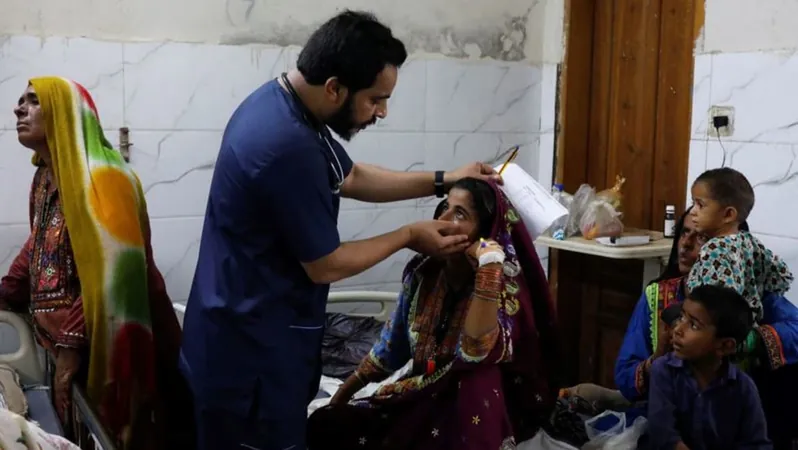
Waterborne Diseases Decimate Pakistani Communities: A Year After the Catastrophic Floods
2024-11-12
Author: Arjun
Desperate Situations in Sujawal
In the heart of Sujawal, Pakistan, despair looms as waterborne diseases ravage the lives of its residents. Fatima Bibi, a mother of five, has watched in anguish as two of her children succumbed to the deadly grips of malaria, a mosquito-borne disease that continues to spread in the aftermath of the nation’s devastating floods.
Fatima’s youngest child, three-year-old Fizza, is battling malaria for the second time in one month. Despite receiving medication from the local hospital, Fatima worries that it's insufficient to combat the life-threatening illness. Living in a mud house devoid of basic sanitation—no toilet or running water—Fatima and her family have to walk half an hour to fetch clean drinking water.
"In our village, dirt and litter are everywhere, and the mosquito population is rampant," Fatima lamented. "What can we do? We're stuck in this cycle of poverty with no means to escape."
This tragic situation is echoed by countless families in the area, where each household faces the grim reality of having at least one child afflicted by waterborne diseases such as diarrhea, cholera, dysentery, or malaria. The hardships are largely attributed to the floods of 2022, which submerged a third of Pakistan, displacing 33 million people and devastating infrastructure. Even two years later, many communities are still grappling with the consequences.
With stagnant floodwaters persisting in southern Sindh province, the risk of waterborne diseases continues to escalate. Health officials have raised alarms about a potential public health crisis, cautioning that urgent measures are needed to combat the ongoing threat.
Contaminated Water Sources and Health Crisis
The dire situation is compounded by the region's lack of access to clean water. To make matters worse, severe monsoon rains have recently exacerbated flooding, inundating ponds, wells, and rivers—leaving families with no choice but to rely on contaminated water for cooking and drinking.
The World Health Organization noted a staggering rise in malaria cases, highlighting that they jumped from 400,000 in 2021 to over 1.6 million in 2022 across Pakistan. Experts, including Sujawal's District Health Officer Muhammad Hanif Memon, assert that improvements in hygiene could drastically reduce disease transmission by 15%. “Collaborative efforts between individuals and the government are crucial,” Memon added.
Infrastructure Deficits and Urgent Needs
Complicating recovery efforts is a severe lack of toilets and sanitation facilities, forcing villagers to resort to open defecation. According to UNICEF, approximately 53,000 Pakistani children die every year from diarrheal diseases caused by inadequate water supply and sanitation.
While the Sindh provincial government aims to address these issues through partnerships with NGOs and UNICEF—installing hand pumps and toilets—there's a growing call for more substantial international support. Sadia Javed, a member of the Sindh Provincial Assembly, emphasized the need for global assistance: “We are a third-world country struggling against overwhelming odds.”
Many observers argue that the government’s focus on climate mitigation often overlooks the needs of the most vulnerable citizens. Environmentalist Ejaz Ahmad highlighted this issue, stating, “Political priorities do not seem to emphasize the dire needs of the poor, who are often the most affected by climate change.
A Health Care System Under Pressure
Medical institutions are facing tremendous pressure as they grapple with overwhelming patient numbers. At the Institute of Maternal and Child Health in southern Sindh, only critical cases of malaria are admitted due to overcrowding; the hospital is treating about 300 to 400 patients at any given time.
Dr. Arshad Ali, a pediatric specialist, noted alarming shortages of essential malaria medications like primaquine, jeopardizing the treatment of many patients. "Inadequate hygiene and sanitation after the floods have created an even tougher battle against disease,” he remarked. “The future of an entire generation is at risk.”
While the challenges are immense, the resilience of communities like Fatima’s speaks volumes. However, without immediate action—both local and international—millions are left vulnerable to the ongoing crisis of waterborne diseases. The time to act is now, or we risk facing a public health disaster of unprecedented proportions.



 Brasil (PT)
Brasil (PT)
 Canada (EN)
Canada (EN)
 Chile (ES)
Chile (ES)
 España (ES)
España (ES)
 France (FR)
France (FR)
 Hong Kong (EN)
Hong Kong (EN)
 Italia (IT)
Italia (IT)
 日本 (JA)
日本 (JA)
 Magyarország (HU)
Magyarország (HU)
 Norge (NO)
Norge (NO)
 Polska (PL)
Polska (PL)
 Schweiz (DE)
Schweiz (DE)
 Singapore (EN)
Singapore (EN)
 Sverige (SV)
Sverige (SV)
 Suomi (FI)
Suomi (FI)
 Türkiye (TR)
Türkiye (TR)